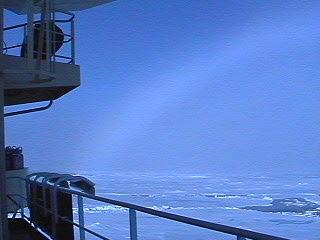
|
|
24 July, 2001
Seismic Science
Tuesday, 24 July 2001
Hej!
Life on Board
I have noticed that often in the evenings about 8 pm, the fog clears, the
sun comes out, and it is beautiful until sometime in the middle of the
night when the fog appears again. I started wondering to myself (and out
loud), "Hmmm, how does the fog know when evening is?" One of the
meteorologists in our Atmospheric Chemistry group, Michael Tjernstrom, from
the University of Stockholm, gives us a weather report every day at our
meeting including 24- and 48-hour forecasts (surprisingly, he is right most
of the time!). The Arctic is not like San Diego where the weather person
can get away with saying, "Late night and early morning fog, cool at the
beach and warmer inland." After our meeting this morning, I asked him
about the fog's disappearance. He suggested that there is enough of a tilt
to the sun's circle-around-the-sky by this of the year to get the sun angle
high enough by about 6 pm to start warming up the fog and causing it to
disperse. He called this a "slight diurnal effect," even though it is not
really noticeable to the naked eye that the sun angle changes throughout
the day.
Where Are We Now?
It was snowing and beautiful this afternoon, with intermittent sunshine
breaking through the clouds to light up the ice. We are heading south
along the Lomonosov Ridge, traversing back and forth across the top. At
4:30 pm, our coordinates were 87o41' North and 134o33' East.
Scientists at Work
For the past several days, the Seismic team from the University of Bergen,
Norway, has been working 24 hours a day on the aft (back) deck of the Oden.
Using an underwater sonic air cannon, they are mapping out the structure of
the Lomonosov Ridge. The air cannon is attached to a cable towed behind
the ship about 10 meters (30 feet) below the ocean surface. Every 30
seconds, it shoots out a strong air pulse which creates a sound wave that
travels down to the ocean floor and bounces back up towards the surface.
Also towed behind the boat is a 450-meter long cable with microphones
attached. The time it takes for the reflected sound wave to reach the
microphones can be used to calculate the distance to the ocean floor for
each pulse. By crossing back and forth over an area and using some
computer technology, they can create a 3-D map of the area.
On the top of the Lomonosov Ridge sits 500 meters of sediments. These
sediments, horizontal and in order, could tell the history of the climate
in the Arctic Basin for the last 500,000 years by drilling a sediment core.
This team of scientists wants to also map below the sediment layer into the
bedrock of the Ridge and perhaps drill some cores here in future
expeditions. They do not have the equipment available on this expedition
to drill cores.
E-MAIL Away up here in the north the satellites are sketchy so I have about
6 minutes on-line before I lose connection. That doesn't leave much time
for email after I send my daily report and no time for email if I send a
picture, too. I managed to look at a few today:
John Lohr: I am glad you sent an answer concerning the whiteness of fog
bows. I had just spoken to our resident fog expert on the Oden, Keith
Biggs from Australia, who seems to spend most of his time collecting fog,
filming fog, and counting ice crystals in fog. Your answer confirmed his
reply that due to the small size of the fog droplets, the pathlength of the
light is not sufficient to produce the colors that are associated with
rainbows. Thanks for your expertise, and everything else. Annie Barnes,
Julianna Snow, Ron Cooper, Dave Wright and everybody at El Capitan High
School: Thanks for help on the phone yesterday and for your good wishes.
Send me some heat! Rochelle and the gang in Boise, Idaho: Hello to all.
Good ham radio to you.
Vi ses! (See you later!)
From Deck 4 on the Icebreaker Oden, somewhere north of 87 on the Lomonosov
Ridge,
Dena Rosenberger

A fog bow off the bow of the Oden
Contact the TEA in the field at
.
If you cannot connect through your browser, copy the
TEA's e-mail address in the "To:" line of
your favorite e-mail package.
|
